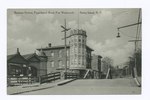Fort Wadsworth Light

Fort Wadsworth Light is a 1903 lighthouse built atop Battery Weed on Staten Island in New York Harbor. The light illuminates the Narrows, the entrance to the harbor. It is located under the Verrazzano-Narrows Bridge. Fort Wadsworth Light was part of the transfer of Fort Wadsworth from the Navy to the National Park Service in March 1995 as part of Gateway National Recreation Area. Its light was visible for 14 nautical miles (26 km; 16 mi). The lantern was possibly moved from Fort Tompkins Light in 1903. When the Verrazzano-Narrows Bridge opened in 1965 the lighthouse became obsolete. Dark for many years, it was restored and converted to solar power by volunteers in 2005.
Excerpt from the Wikipedia article Fort Wadsworth Light (License: CC BY-SA 3.0, Authors, Images).Fort Wadsworth Light
South Weed Road, New York Staten Island
Geographical coordinates (GPS) Address Nearby Places Show on map
Geographical coordinates (GPS)
| Latitude | Longitude |
|---|---|
| N 40.605833333333 ° | E -74.053888888889 ° |
Address
Battery Weed
South Weed Road
10305 New York, Staten Island
New York, United States
Open on Google Maps









